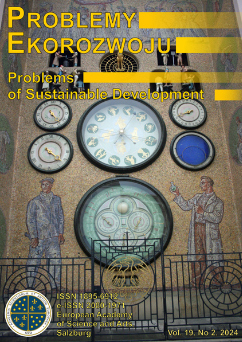Wpływ czynnika środowiskowego na dynamikę rozwoju prawa sąsiedzkiego w kontekście problematyki rozwoju zrównoważonego
Aleksey Anisimov
Chair of Civil Law, Volgograd Institute of Business, Volgograd (Federacja Rosyjska)
Irina Emelkina
Chair of Civil Law and Procedure, Mordovia State National Research University, Saransk (Federacja Rosyjska)
Anatoliy Ryzhenkov
Chair of Civil Law, Volgograd Institute of Business, Volgograd (Federacja Rosyjska)
Abstrakt
Artykuł przedstawia rozwój prawa sąsiedzkiego począwszy od starożytności po czasy obecne. Autorzy udowadniają, że już w połowie XIX w. zagrożenia środowiskowe i technologiczne odgrywały istotną rolę w relacjach sąsiedzkich, a od początku XXI w. wzbogaciły się o nowy atrybut systemowy związany początkami ery globalizacji. Rozwój zrównoważony na poziomie lokalnym pozostaje pod znaczącym wpływem dynamiki osadniczej, związanej z powstawaniem gigantycznych mega-metropolii, zamieszkiwanych w tym samym czasie przez miliony ludzi. Warunkuje to powstawanie nowych typy konfliktów sąsiedzkich, dotąd nieznanych. Postsowieckie nauki prawne, sądy i prawodawstwo, nie są do takiej sytuacji przygotowane. Ponadto już teraz możemy dostrzec zarysy nowych środowiskowych zagrożeń dla zrównoważonego rozwoju i to na wszystkich jego poziomach, a związane z rozwojem zielonej energii, nanotechnologii i postępujących zmian klimatycznych. Nie ma także prostych sposobów rozwiązywania konfliktów sąsiedzkich – należy stworzyć zintegrowany system kontroli i przeciwdziałania, który uwzględniałby zarówno środki publiczne, jak i prywatne.
Słowa kluczowe:
sąsiedzi, konflikty, środowisko, technologie, prywatne prawo, rozwójBibliografia
ANTSIFEROVA I.V., 2012, Sources of release of nanoparticles into the environment, in: Bulletin of Perm National Research Polytechnic University, Machine building, materials science, Vol. 14-2, p. 54-66.
Google Scholar
APPLE B.E., 2014, Mapping Fracking: an Analysis of Law, Power, and Regional Distribution in the United States, in: Harvard Environmental Law Review, Vol. 38, p. 220.
Google Scholar
EISEN J.B., 1999, Brownfields policies for sustainable cities, in: Duke Environmental Law & Policy Forum, Vol. 9, p. 199.
Google Scholar
IRO G., 2008, Bürgerliches recht. B. IV. Sachenrecht. Dritte Auflage, Wien, New York, p. 62-75.
Google Scholar
JOHNSON E.J., 1996/97, Environmental Stigma Damages: Speculative Damages in Environmental Tort Cases, in: Journal of Environmental Law, Vol. 15, p. 187.
Google Scholar
KALINICHEV A.V., 2007, Land easement in Russian legislation: abstract of the thesis of the candidate of jurisprudence, Moscow State Social University, Moscow, p. 57.
Google Scholar
KLASS A.B., 2011, Property Rights on the New Frontier: Climate Change, Natural Resource Development, and Renewable Energy, in: Ecology Law Quarterly, Vol. 38, p. 97-103.
Google Scholar
KOVALEVA N.V., 2015, Technical legal regulation of industrial production of the Russian Empire of the XIX- the beginning of the XX centuries: abstract of the thesis of the doctor of jurisprudence, Institute of Legislation and Comparative Law under the Government of the Russian Federation, Moscow, p. 21-51.
Google Scholar
KRAMER B.M., 1996, Local Land Use Regulation of Extractive Industries: Evolving Judicial and Regulatory Approaches, in: Journal of Environmental Law, Vol. 14, p. 56.
Google Scholar
LEWYN M., 2015, Yes to Infill, no to Nuisance, in: Fordham Urban Law Journal, Vol. XLII, p. 853.
Google Scholar
LOSHIN J., 2006, Property in the Horizon: The Theory and Practice of Sign and Billboard Regulation, in: Environs, Vol. 30, p. 144-153.
Google Scholar
MANK B.C., 1995, Environmental Justice and Discriminatory Siting: Risk-Based Representation and Equitable Compensation, in: Ohio State Law Journal, Vol. 56, no.2, p. 337.
Google Scholar
MORRISS A.P., MEINERS R.E., 2003, Market Principles for Pesticides, in: William & Mary Environmental Law and Policy Review, Vol. 28, p. 67-70.
Google Scholar
MURPHY L.B., 2008, CAFO Grief: Using Tax Grieving Procedures to Protest Industrial Animal Factories, in: Journal of Environmental Law and Litigation, Vol. 23, p. 360-361.
Google Scholar
NEFEDOV L.V., 2015, Concept ‘neighbor law’ in the Soviet land legislation, in: History of state and law, Vol. 5, p. 47-51.
Google Scholar
PENSLEY D.S., 2008, The Legalities of Stream Interventions: Accretive Changes to New York State's Riparian Doctrine Ahead?, in: Pace Environmental Law Review, Vol. 25, p. 117.
Google Scholar
POKROVSKY I.A., 1999, History of Roman law, Sankt Petersburg, p. 196.
Google Scholar
SARLO C.H., 1999, A Comparative Analysis: The Affirmative Defense of an Innocent Landowner versus the Prima Facie Case of a Toxic Tort Plaintiff: Can CERCLA's Innocent Landowner Provision Be Used as a Defense in a Toxic Tort Suit?, in: Pace Environmental Law Review, Vol. 16, no. 2, p. 272-278.
Google Scholar
SOMMERS L., 2005, A Practical Guide to Measure 37, in: Journal of Environmental Law and Litigation, Vol. 20, p. 218-219.
Google Scholar
STATE REPORT, 2012, On the State and Protection of the Environment in the Russian Federation in 2011, Moscow, p. 67.
Google Scholar
STATE REPORT, 2014, On the State and Protection of the Environment in the Russian Federation in 2013, Мoscow, p.13-14.
Google Scholar
STATHOPOULOS A.S., 2010, You Are What Your Food Eats: How Regulation Of Factory Farm Conditions Could Improve Human Health And Animal Welfare Alike, in: New York University Journal of Legislation and Public Policy, Vol. 13, p. 428.
Google Scholar
SYLKINA S.M., 2016, International legal aspects of rational use of alternative energy sources, http://rusnauka.com/Page_ru.htm
Google Scholar
(16.05.2016).
Google Scholar
THE LAW CODE OF THE KING HAMMURAPI, 1996, in: Sources of law. Issue 1, Tolyatti, p. 3-55.
Google Scholar
THE LAWS OF MANU, http://rozamira.narod.ru/Biblioteka/Zakony_Manu.htm,
Google Scholar
http://www.sacred-texts.com/hin/manu.htm (16.05.2016).
Google Scholar
WALKER R.K., 2011, The answer, my friend, is blowin’ in the wind: nuisance suits and the perplexing future of American wind farms, in: Drake Journal of Agricultural Law, Vol. 16, p. 520-521.
Google Scholar
VINICHENKO Yu.V., 2013, Emergence of neighborhood relations and neighbor law in Russia, in: Prolog, Vol. 1, p. 21-23.
Google Scholar
Autorzy
Aleksey AnisimovChair of Civil Law, Volgograd Institute of Business, Volgograd Federacja Rosyjska
Autorzy
Irina EmelkinaChair of Civil Law and Procedure, Mordovia State National Research University, Saransk Federacja Rosyjska
Autorzy
Anatoliy RyzhenkovChair of Civil Law, Volgograd Institute of Business, Volgograd Federacja Rosyjska
Statystyki
Abstract views: 18PDF downloads: 10
Licencja

Utwór dostępny jest na licencji Creative Commons Uznanie autorstwa – Na tych samych warunkach 4.0 Miedzynarodowe.




